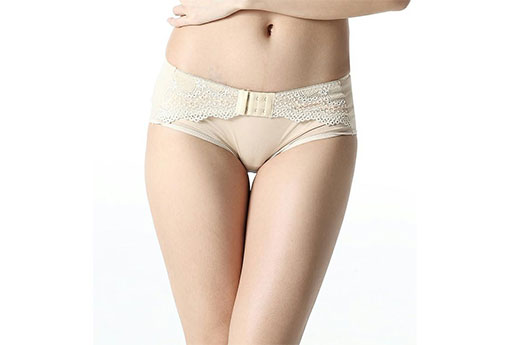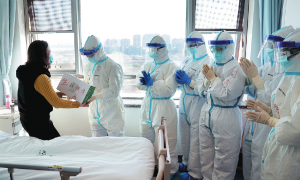Basic Information
Chinese name: clitoris
Foreign name: Clitoris
Other Names: Yin Nucleus
Shape: cylindrical
Function: Stimulate women's libido and pleasure
Appearance introduction
The clitoris is divided into three parts
1. The front is the clitoral head, exposed to the vulva, rich in nerve endings, and the sexual response organ
2. The middle is the clitoral body
3. The back is the clitoral peduncle, which is attached to the two pubic ramus.
The clitoris, also known as the clitoris, the vulva, etc. (English: Clitoris). The apex between the labia minora on both sides is the meeting point of the upper ends of the labia majora on both sides. It is a small cylindrical organ, surrounded by the clitoral foreskin, about 2-4 cm long. At the end is a round head with an enlarged tip called the clitoral head. The superficial skin, the inner end is joined by a thin bundle of erectile tissue. Erectile tissue is a kind of cavernous tissue (composed of two erectile clitoral cavernous bodies, divided into three parts: head, body, and feet. It is equivalent to the male penis cavernous body), with rich venous plexus and rich nerve endings, so Sensitive and prone to bleeding after injury. Although the clitoris is in the external genitalia, it does not have reproductive function, but is the most important sexually sensitive part.
The clitoris, especially the clitoral head, is full of nerve endings, slight touch or stimulation can cause strong sexual arousal and sexual pleasure, and even proper stimulation can make women achieve orgasm, so it is also the favorite stimulation site for female masturbation. During sexual intercourse, the penis generally does not directly stimulate the clitoris.
A woman's clitoris is equivalent to a man's penis, and the clitoral head is equivalent to the glans. Except for the smaller and differentiated urethral corpus cavernosum, it is like the penis, with clitoral body, feet, glans, foreskin, corpus cavernosum and sarcolemma, and comb-strength septum, and suspensory ligament. Erection when sexually stimulated.
The position of the clitoris to shape
The clitoris is located at the tip of the anterior commissure of the labia and consists of a pair of clitoral corpora cavernosa. The entire clitoris consists of the clitoral foot, the clitoral body, and the clitoral head. A well-developed clitoris can be seen from the outside about 2 cm in length and 0.5 cm in diameter. The clitoris is the organ with the most abundant and sensitive nerves in women. It is usually wrapped by the clitoral foreskin and will only be exposed after entering a state of sexual excitement. When fully erected, it feels as hard as the tip of the nose.
basic structure
Clitoral Structure According to FFWHCS, the complete clitoris consists of 18 parts:
1. The clitoral junction (or the anterior commissure, the point where the outer labia meets the base of the mons pubis, marks the upper border of the visible portion of the clitoris.)
2, clitoral head.
3. The inner labia (or labia minora).
4, clitoral foreskin.
5. The clitoral frenulum is the point where the outer edge of the inner labia meets the clitoral head.
6. The labia frenulum, which is a stretched membrane, that is located under the inner labia in the vagina. Above the point where the mouth meets, marks the lower border of the visible part of the clitoris.
7. The hymen, or the remnants of the hymen, can be seen inside the vaginal opening.
8. The clitoral body, which connects the clitoral head and the clitoral feet.
9. The clitoral peduncle (or clitoral shin), the two extensions of the erectile tissue, are shaped like a Y-shaped wishbone.
10. The clitoral bulbs (vestibular bulbs), two giant erectile spongy tissues that correspond to the individual spheres of the penis.
11. The corpus cavernosum, the erectile spongy tissue surrounding the urethra.
12. Paraurethral gland group: female prostate group.
13 The Bartholin's gland, or Bartholin's gland, produces a small amount of lubricant outside the vagina.
14. The perineal corpus cavernosum, or body of the perineum, is located in the dense network of blood vessels that lie beneath the perineum.
15. Pelvic floor muscles:
a, BC muscle (bulbocavernosus muscle), located in the clitoral bulb and anal sphincter,
b, IC muscle (ischiocavernosus muscle), which constitutes the triangular opening of the pelvis. Or rather, attached to those bones on which we sit.
c. The TP muscle (transversus perineum), the broad-bandlike muscle that forms the bottom of the pelvic opening, is intertwined with the bulbocavernosus muscle and the cross-section of the anal sphincter.
d. UD muscle (perineal fascia), a triangular flat muscle located below the opening of the pelvis.
e. The LA muscle (levator ani), part of the pelvic fascia, is a broad, flat, funnel-shaped muscle located at the bottom of the pelvic floor.
16. The suspensory and round ligaments.
17. Nerves: The pudendal nerve, or as I like to call it, the organ nerve complex, may also be the hypogastric nerve that transmits information back and forth from the uterus.
18. Vascular: During sexual response, it supplies greatly increased blood.
Looking at it now, it looks like a power plant.
Features
The clitoris is an amazing and unique organ in the entire human anatomy. It is the only human organ that is only related to sexual desire and sexual feelings, and its only physiological function is to stimulate women's sexual desire and pleasure. As the erotic center of afferent and efferent sexual stimuli, it has the dual roles of the most sensitive receptor and the most powerful sensor. The clitoris is located at the anterior meeting point of the labia majora at the front of the vulva, between the labia minora on both sides. The clitoris is composed of a pair of corpus cavernosums capable of erection and swelling. It is divided into three parts: head, body and feet. It is wrapped in a dense envelope mainly composed of elastic fibers and smooth muscle bundles. Comb-shaped septum. A small, mung bean-sized bulge of the clitoral head emerges from the clitoral prepuce, the only visible part of the clitoris, which is the only visible part of the clitoris, with the clitoral frenulum beneath it, a skin fold that surrounds the clitoris formed by the forward confluence of the labia minora on both sides. The clitoral head of many women has been hidden in the long and tight clitoral foreskin before they feel a strong sexual impulse, and the clitoral head can only be clearly exposed when a considerable degree of sexual excitement is reached. The diameter and length of the clitoral head are both around 2-5 mm, and there are large individual differences in their size, even if they are as thick as 10 mm, it is normal. The clitoral body has been wrapped in the clitoral foreskin. After it leaves the lower part of the anterior border of the pubic symphysis, it bends almost at a right angle and turns to the anterior and inferior protrusions, which is called the pendulous part, and its free end is the clitoral head.
The clitoris is rich in sensitive nerve endings that are 6-10 times denser than surrounding tissue or the glans of the penis. The innervation of the clitoris is the dorsal clitoral nerve, a small branch of the most terminal pudendal nerve, which terminates in the nerve ending plexus of the head and body of the clitoris. Circumferential corpuscles associated with proprioceptive stimuli are irregularly distributed on the larger bundles of the dorsal clitoral nerve, and they play an important role in transmitting afferent impulses elicited by somatoform stimuli. The cricolamellar corpuscles act on deep pressure and proprioception, and their quantity and quality vary greatly, so it can explain why the difference in stimulation technique and intensity required by women during masturbation is so great.
The clitoris is also rich in free nerve endings that are very sensitive to touch, which shows why the clitoris is so sensitive to touch. If the clitoris is subtly stimulated, it is often easy to stimulate women's libido, and it can often make women without sexual intercourse. to orgasm. In general, stimulation of the clitoral body is better than direct stimulation of the clitoral head. In addition, the clitoris often needs continuous and strong stimulation for a long time. After all, it is separated by a layer of foreskin, so its tolerance is good, especially when it is near orgasm, it needs to be stimulated with force and a large amount. The process of stimulating the clitoris is not only a moment to mobilize a woman's subjective initiative and sexual desire, but also a moment to make the woman quickly transition from the excitement period to the plateau period. The woman must actively participate, be a good guide and commander, and clearly point out to the man her most sensitive parts and areas. Favorite stimulation method, full communication at any time to correct the deviation or deficiency of the man's stimulation method. Otherwise, letting the blind man ride a blind horse will not only waste time and energy, but also make the woman feel disappointed and irritable.
According to statistics, 2/3 of women are more willing to accept clitoral stimulation, and only 1/3 of women prefer vaginal stimulation. Women who are willing to accept clitoral stimulation think that the pleasure brought by clitoral stimulation is far stronger than that of vaginal stimulation. Although sex experts have clearly established the important role of clitoral stimulation in women's sexual response, there are still many women who do not accept this practice. In most sexual positions, the penis cannot directly stimulate the clitoris. Moreover, when the sexual response enters the plateau phase, due to the contraction of the female perineal muscles, the clitoris will retreat from its usual pendulous position to the depths of the clitoral foreskin, close to the pubic symphysis. the anterior border, thus far away from the vaginal opening. This withdrawal makes it more difficult for the penis to make direct contact with the clitoris. In fact, during pure vaginal intercourse, the twitching of the penis in the vagina will indirectly stimulate the clitoris through the back and forth of the labia minora and the clitoral foreskin attached to it, especially when the penis is twitched outwards and the foreskin returns to the glans or coronal When the groove is placed, the diameter of the penis increases by a few millimeters, which makes it easier for indirect stimulation of the clitoris.
the size of the clitoris
The size of the clitoris may be influenced by genetic and endocrine factors, and its appearance is related to the development of adjacent tissues. Although the skin, foreskin, and labia minora of the clitoral glans may fold, proliferate, and chronically engorged with frequent sexual stimulation, the clitoral corpus cavernosum does not exhibit such reactive hyperplasia. Some people think that masturbation in women can lead to clitoral hypertrophy. Similarly, there is no scientific basis for men to worry that their masturbation will cause the penis to shrink or affect its normal growth. Some young women are often worried about the abnormal development of their external genitalia and like to compare themselves with their peers when taking a bath, thus causing a serious psychological burden.
The size, shape, and position of the female clitoris varies greatly among individuals. A small number of people have abnormal hypertrophy due to long-term use of estrogen or excessive androgen secretion in the body; individual clitoral heads are also divided into two halves, which are only connected at the root. Genital abnormalities in adolescent girls are not uncommon. If there is an abnormal arrangement of genes in chromosomes, especially sex chromosomes, there is a disease or abnormality. In addition, in the process of embryonic development, affected by the interference of internal and external environment, such as mother's illness, wrong medication, X-ray irradiation, inhalation of toxic and harmful gases or dust, etc., can also cause embryonic developmental aberrations and deformities. Virilization of women can occur when the endocrine organs are abnormal. The gonads are the main organs that determine sex, and the sex hormones they secrete play a major role in sex determination. In addition, the reticular zone of the adrenal cortex also produces some sex hormones, which are opposite sex hormones.
change in sexual response
Changes in the clitoris during the sexual response cycle:
Due to people's long-standing misconceptions about sex and people's misconceptions about sex and reproductive system, the research on the truth of the sexual response process has been seriously hindered; coupled with technical difficulties, such as in a certain Some intercourse positions or when women are self-stimulating interfere with clinical observations or make them impossible at all, so reports on the anatomical and physiological changes of the clitoris during the sexual response cycle are introduced late. Sexual stimulation has two forms of physical and psychological sources, and the clitoris can also respond appropriately to these two different types of sexual stimulation. Although there are physical and psychological sources of stimuli, and the clitoris acts as both a receptor and a sensor, this does not mean that a certain form of stimulation is purely somatic. Because all stimuli are identified, conducted and classified by higher cortical centers. The so-called somatic stimulation only involves physical activities. This form of clitoral stimulation varies widely, and can be manual massage or other stimulation between the sexes, or self-stimulation with bedding or leg pressure.
So the use of the term somatic stimulation or sensor action is meant to be general, not to any particular means of initiation. In any method of female sexual stimulation, the overlapping of psychosexual factors in nature is always important and cannot be ignored.
The first perineal reaction to sexual stimulation is an increase in vaginal secretions, which forms a preparatory condition for lubrication. It is only 10-30 seconds from the onset of stimulation to the "sweating" reaction of the vaginal walls. The clitoris does not respond so quickly. Most people mistakenly imagine that since the clitoris and the penis are homologous tissues and have similar anatomical structures, the response time to similar stimuli should also be similar, so the clitoris should also be like the penis. "Reaction, but this inference proved wrong. How quickly the clitoral response occurs depends on whether the nature of the sexual stimulation is direct or indirect. The only direct stimulation methods are manual or mechanical stroking and pressing of the clitoral body or the entire mons pubis area, while indirect stimulation techniques vary and include breast (especially nipple), or vaginal stimulation (not Touching the clitoris), caressing other sensitive areas of the body that can cause sensuality, various sexual visions or audio-visual stimulation, a variety of sexual positions that do not directly touch the clitoris and artificial sexual intercourse experiments.
In thousands of direct observations of women's sexual response cycles, it was found that clinical evidence of clitoral head swelling was seen in less than half of the cases, and the degree of vascular congestion was also different, and some were barely identifiable. Some can double the original size. The clitoral erectile tissue is primarily regulated by the parasympathetic nerves that innervate it. This reaction was once confused with the erection of the penis and called it the "erect" of the clitoris, but in the actual investigation, it was found that unless there was pathological hypertrophy, the so-called clitoral erection could not be seen. The swelling of the clitoris is parallel to the vascular congestion of the labia minora, which is supplied by the deep clitoral and dorsal arteries.
once the clitoral swollen reaction occurs and the sexual stimulation that brings the woman to a state of arousal continues, it can persist throughout the sexual response cycle. The presence or absence of a swelling reaction cannot be foreseen in advance. There are significant differences in the degree and the speed of the swelling response volume increase, such as the direct stimulation, the response is rapid and strong, while the indirect stimulation, the response is significantly delayed and weak.
When unstimulated, the clitoral foreskin can shrink slightly but does not retreat, and its degree of freedom of movement is obviously not as good as that of the foreskin of the penis or the skin of the scrotum. As the clitoral head swells in volume, it becomes firmly fixed between the previously loose but now engorged clitoral foreskin and the clitoral frenulum below it. The clitoral corpus also experiences an excitatory hyperemic response to enlargement and growth that coincides with the onset of swelling of the clitoral glans, regardless of the source or type of stimulation. Both women who can achieve multiple orgasms in succession or women who cannot achieve orgasm are likely to have the above-mentioned clitoral head and body reactions during sexual activity, which have nothing to do with sexual ability and degree of sexual response. The primary clitoral response to effective stimulation occurs during the plateau phase of the sexual response cycle.
The clitoral head and body will be retracted from the normal pudendal pendant position posteriorly and abut against the anterior border of the pubic symphysis due to the contraction of various muscle bundles, including the clitoral peduncles, suspensory ligaments, and ischiocavernosus. Especially when the orgasm is imminent, the whole clitoral head and body are hidden under the protective clitoral foreskin, and they can no longer be observed clinically. At this moment, there is at least a 50% reduction in the length of the entire clitoral body. During the plateau phase, the occurrence of clitoral subject withdrawal responses is related to the mode and effectiveness of sexual stimulation. During intercourse or breast manipulation, clitoral retraction occurs at the end of the plateau as an indication that sexual tension has reached pre-climax levels. With manual stimulation of the mons pubis area, clitoral subject withdrawal will occur more rapidly, usually early in the plateau, which tends to indicate that it is a response to tactile stimulation rather than an imminent orgasm. The withdrawal response of the clitoral body that occurs during the plateau phase is reversible, if the means of stimulation is intentionally weakened or discontinued, the level of sexual tension will drop immediately, and the withdrawn clitoral shaft and head will return to the normal pendulous position. The withdrawal of the clitoral body will reappear when effective stimulation is resumed. This sequence of clitoral responses will recur when the plateau is maintained for a long time.
Due to the severe retraction of the clitoris in the late stage of the platform, direct observation of the clitoris during orgasm is not possible, so it is not yet certain what special clitoral reactions will be during orgasm. The clitoris returns to its normal pendulous position within 5-10 seconds after the contractions of the orgasmic platform stop at the onset of the resolution phase, which occurs in tandem with the subsidence of the labia minora skin color. But the subsidence of the swelling of the clitoral glans (if it does occur during arousal) is a slow process, and the more severe the swelling, the slower it will subside.
In general, congestion and swelling of the clitoral glans and clitoral body often persists for 5-10 minutes or more after an orgasmic expression. For women who do not have an orgasm, the venous swelling of the main body of the clitoris often persists for hours after all sexual stimulation has ceased.
It is worth reminding that the clitoral head will become extremely sensitive to any sense of touch or pressure after orgasm, so women who desire multiple orgasms should take care to avoid touching the clitoral head directly when restarting a new stimulation, and pay attention to it. The force is transferred to the entire mons pubis area. Especially after termination of orgasm caused by G-spot stimulation, the clitoris and its surrounding tissues reject any form of further stimulation.
So it has also been suggested that women also have a refractory period, but in general, this period is much shorter than that of men.








